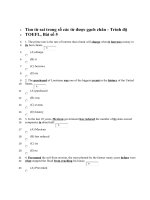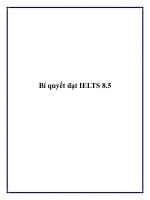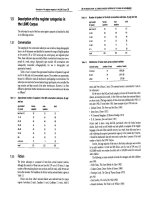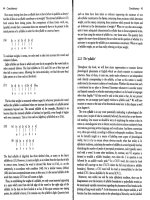Structure question 5 pot
Bạn đang xem bản rút gọn của tài liệu. Xem và tải ngay bản đầy đủ của tài liệu tại đây (85.89 KB, 6 trang )
Example
Determine if these two triangles are congruent.
Although the triangles are not aligned the same, there are two congruent corresponding sides, and
the angle between them (150°) is congruent. Therefore, the triangles are congruent by the SAS pos-
tulate.
Example
Determine if these two triangles are congruent.
Although the triangles have two congruent corresponding sides, and a corresponding congruent
angle, the 150° angle is not included between them. This would be “SSA,” but SSA is not a way to
prove that two triangles are congruent.
Area of a Triangle
Area is the amount of space inside a two-dimensional object. Area is measured in square units, often written as
unit
2
. So, if the length of a triangle is measured in feet, the area of the triangle is measured in feet
2
.
A triangle has three sides, each of which can be considered a base of the triangle. A perpendicular line seg-
ment drawn from a vertex to the opposite base of the triangle is called the altitude, or the height. It measures how
tall the triangle stands.
It is important to note that the height of a triangle is not necessarily one of the sides of the triangle. The cor-
rect height for the following triangle is 8, not 10. The height will always be associated with a line segment (called
an altitude) that comes from one vertex (angle) to the opposite side and forms a right angle (signified by the box).
In other words, the height must always be perpendicular to (form a right angle with) the base. Note that in an obtuse
triangle, the height is outside the triangle, and in a right triangle the height is one of the sides.
Obtuse Triangle
b
h
Right Triangle
b
h
b
h
Acute Triangle
8"
150˚
11"
8"
150˚
11"
8"
150˚
6"
8"
150˚
6"
– THEA MATH REVIEW–
160
The formula for the area of a triangle is given by A =
ᎏ
1
2
ᎏ
bh,where b is the base of the triangle, and h is the
height.
Example
Determine the area of the triangle below.
A =
ᎏ
1
2
ᎏ
bh
A =
ᎏ
1
2
ᎏ
(5)(10)
A = 25 in
2
VOLUME FORMULAS
A prism is a three-dimensional object that has matching polygons as its top and bottom. The matching top and
bottom are called the bases of the prism. The prism is named for the shape of the prism’s base, so a triangular
prism has congruent triangles as its bases.
Note: This can be confusing. The base of the prism is the shape of the polygon that forms it; the base of a
triangle is one of its sides.
Height of prism
Base of
p
rism
10"
5"
10
10
12
8
– THEA MATH REVIEW–
161
Vol u m e is the amount of space inside a three-dimensional object. Volume is measured in cubic units, often
written as unit
3
. So, if the edge of a triangular prism is measured in feet, the volume of it is measured in feet
3
.
The volume of ANY prism is given by the formula V = A
b
h,where A
b
is the area of the prism’s base, and h
is the height of the prism.
Example
Determine the volume of the following triangular prism:
The area of the triangular base can be found by using the formula A =
ᎏ
1
2
ᎏ
bh, so the area of the base is
A =
ᎏ
1
2
ᎏ
(15)(20) = 150. The volume of the prism can be found by using the formula V = A
b
h, so the
volume is V = (150)(40) = 6,000 cubic feet.
A pyramid is a three-dimensional object that has a polygon as one base, and instead of a matching polygon
as the other, there is a point. Each of the sides of a pyramid is a triangle. Pyramids are also named for the shape
of their (non-point) base.
The volume of a pyramid is determined by the formula
ᎏ
1
3
ᎏ
A
b
h.
Example
Determine the volume of a pyramid whose base has an area of 20 square feet and stands 50 feet tall.
Since the area of the base is given to us, we only need to replace the appropriate values into the formula.
V =
ᎏ
1
3
ᎏ
A
b
h
V =
ᎏ
1
3
ᎏ
(20)(50)
V = 33
ᎏ
1
3
ᎏ
The pyramid has a volume of 33
ᎏ
1
3
ᎏ
cubic feet.
40'
20'
15'
– THEA MATH REVIEW–
162
Polygons
A polygon is a closed figure with three or more sides, for example triangles, rectangles, pentagons, etc.
Shape Number of Sides
Circle 0
Triangle 3
Quadrilateral (square/rectangle) 4
Pentagon 5
Hexagon 6
Heptagon 7
Octagon 8
Nonagon 9
Decagon 10
TERMS RELATED TO POLYGONS
■
Ve r t i c e s are corner points, also called endpoints, of a polygon. The vertices in the above polygon are:
A, B, C, D, E, and F and they are always labeled with capital letters.
■
A regular polygon has congruent sides and congruent angles.
■
An equiangular polygon has congruent angles.
Interior Angles
To find the sum of the interior angles of any polygon, use this formula:
S = 180(x – 2)°, where x = the number of sides of the polygon.
A
B
C
DE
F
– THEA MATH REVIEW–
163
Example
Find the sum of the interior angles in the polygon below:
The polygon is a pentagon that has 5 sides, so substitute 5 for x in the formula:
S = (5 – 2) ϫ 180°
S = 3 ϫ 180°
S = 540°
EXTERIOR ANGLES
Similar to the exterior angles of a triangle, the sum of the exterior angles of any polygon equals 360 degrees.
S
IMILAR POLYGONS
If two polygons are similar, their corresponding angles are congruent and the ratios of the corresponding sides
are in proportion.
Example
These two polygons are similar because their angles are congruent and the ratios of the correspon-
ding sides are in proportion.
3
2
5
3
6
10
6
10
4
5
A
B
C
D
E
V
X
W
Y
Z
ЄA = ЄV = 140°
ЄB = ЄW = 60°
ЄC = ЄX = 140°
ЄD = ЄY = 100°
ЄE = ЄZ = 100°
AB
VW
3
6
3
6
5
10
5
10
BC
WX
CD
XY
DE
YZ
EA
ZV
2
4
====
– THEA MATH REVIEW–
164
Quadrilaterals
A quadrilateral is a four-sided polygon. Since a quadrilateral can be divided by a diagonal into two triangles, the
sum of its interior angles will equal 180 + 180 = 360 degrees.
m∠1 + m∠2 + m∠3 + m∠4 + m∠5 + m∠6 = 360°
Parallelograms
A parallelogram is a quadrilateral with two pairs of parallel sides.
In the figure above, AB
|| CD
and BC
|| AD
. Parallel lines are symbolized with matching numbers of trian-
gles or arrows.
A parallelogram has:
■
opposite sides that are congruent (A
ෆ
B
ෆ
= C
ෆ
D
ෆ
and B
ෆ
C
ෆ
= A
ෆ
D
ෆ
)
■
opposite angles that are congruent (m∠A = m∠C and m∠B = m∠D)
■
consecutive angles that are supplementary (m∠A + m∠B = 180°, m∠B + m∠C = 180°,
m∠C + m∠D = 180°, m∠D + m∠A = 180° )
■
diagonals (line segments joining opposite vertices) that bisect each other (divide each other in half)
SPECIAL TYPES OF PARALLELOGRAMS
■
A rectangle is a parallelogram that has four right angles.
y
x
x
y
A
B
C
D
1
3
4
5
6
2
– THEA MATH REVIEW–
165









